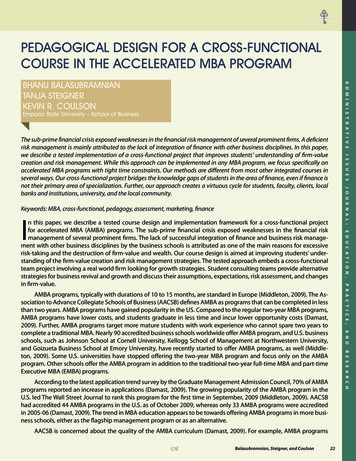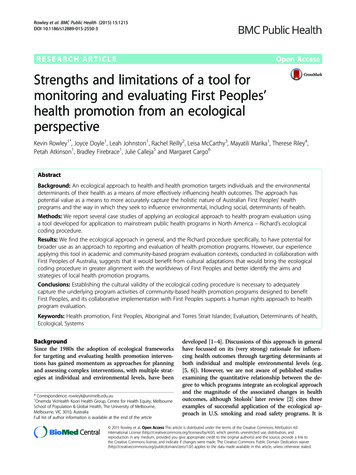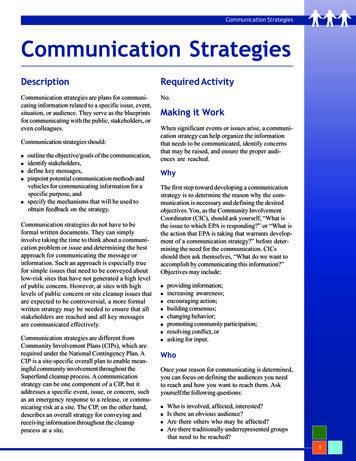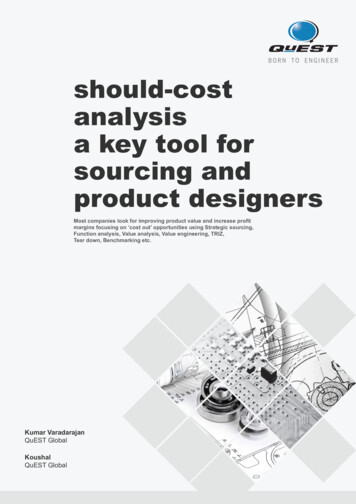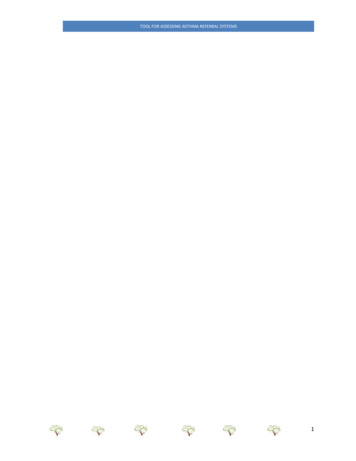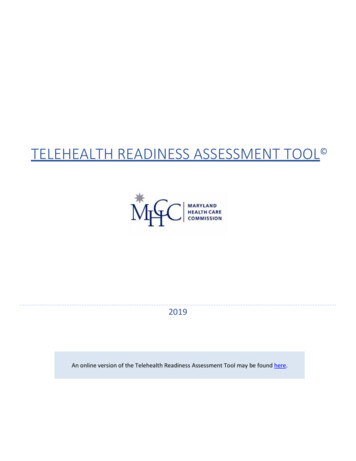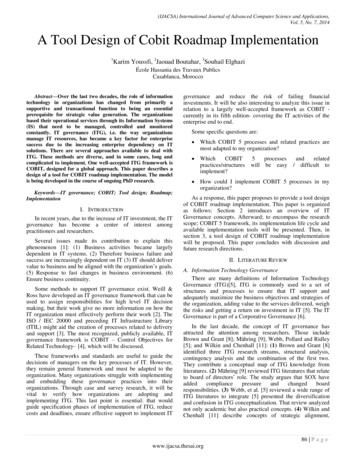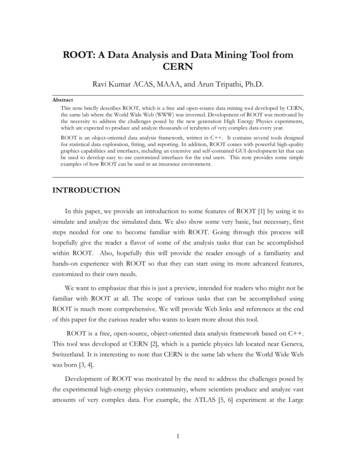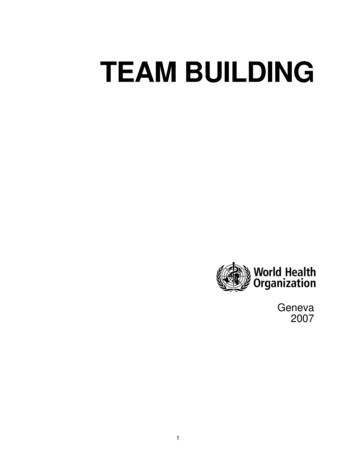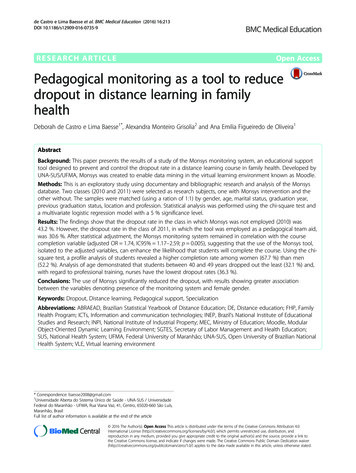
Transcription
de Castro e Lima Baesse et al. BMC Medical Education (2016) 16:213DOI 10.1186/s12909-016-0735-9RESEARCH ARTICLEOpen AccessPedagogical monitoring as a tool to reducedropout in distance learning in familyhealthDeborah de Castro e Lima Baesse1*, Alexandra Monteiro Grisolia2 and Ana Emilia Figueiredo de Oliveira1AbstractBackground: This paper presents the results of a study of the Monsys monitoring system, an educational supporttool designed to prevent and control the dropout rate in a distance learning course in family health. Developed byUNA-SUS/UFMA, Monsys was created to enable data mining in the virtual learning environment known as Moodle.Methods: This is an exploratory study using documentary and bibliographic research and analysis of the Monsysdatabase. Two classes (2010 and 2011) were selected as research subjects, one with Monsys intervention and theother without. The samples were matched (using a ration of 1:1) by gender, age, marital status, graduation year,previous graduation status, location and profession. Statistical analysis was performed using the chi-square test anda multivariate logistic regression model with a 5 % significance level.Results: The findings show that the dropout rate in the class in which Monsys was not employed (2010) was43.2 %. However, the dropout rate in the class of 2011, in which the tool was employed as a pedagogical team aid,was 30.6 %. After statistical adjustment, the Monsys monitoring system remained in correlation with the coursecompletion variable (adjusted OR 1.74, IC95% 1.17–2.59; p 0.005), suggesting that the use of the Monsys tool,isolated to the adjusted variables, can enhance the likelihood that students will complete the course. Using the chisquare test, a profile analysis of students revealed a higher completion rate among women (67.7 %) than men(52.2 %). Analysis of age demonstrated that students between 40 and 49 years dropped out the least (32.1 %) and,with regard to professional training, nurses have the lowest dropout rates (36.3 %).Conclusions: The use of Monsys significantly reduced the dropout, with results showing greater associationbetween the variables denoting presence of the monitoring system and female gender.Keywords: Dropout, Distance learning, Pedagogical support, SpecializationAbbreviations: ABRAEAD, Brazilian Statistical Yearbook of Distance Education; DE, Distance education; FHP, FamilyHealth Program; ICTs, Information and communication technologies; INEP, Brazil’s National Institute of EducationalStudies and Research; INPI, National Institute of Industrial Property; MEC, Ministry of Education; Moodle, ModularObject-Oriented Dynamic Learning Environment; SGTES, Secretary of Labor Management and Health Education;SUS, National Health System; UFMA, Federal University of Maranhão; UNA-SUS, Open University of Brazilian NationalHealth System; VLE, Virtual learning environment* Correspondence: baesse2008@gmail.com1Universidade Aberta do Sistema Único de Saúde - UNA-SUS / UniversidadeFederal do Maranhão - UFMA, Rua Viana Vaz, 41, Centro, 65020-660 São Luís,Maranhão, BrasilFull list of author information is available at the end of the article 2016 The Author(s). Open Access This article is distributed under the terms of the Creative Commons Attribution 4.0International License (http://creativecommons.org/licenses/by/4.0/), which permits unrestricted use, distribution, andreproduction in any medium, provided you give appropriate credit to the original author(s) and the source, provide a link tothe Creative Commons license, and indicate if changes were made. The Creative Commons Public Domain Dedication o/1.0/) applies to the data made available in this article, unless otherwise stated.
de Castro e Lima Baesse et al. BMC Medical Education (2016) 16:213BackgroundThe process of teaching and learning is a complex phenomenon. Educational achievement requires students toaccess learning opportunities, to persist in their learningactivities, and to complete the required stages of acourse of study. When one of these links in the educational provision breaks, educational failure occurs [1].Experts disagree on the primary causes for educationalfailure. Some experts view failure as an individualprocess, related only to the student’s ability to assimilatecontent. For others, it is an institutional process that results from the organizational form of the curriculum,methodologies and evaluation. Finally, for still others, itis a socio-political process that stems from context [2].In the research described herein, educational failure istreated as a complex phenomenon involving numerousfactors that contribute to “failure to learn” and for whichrepetition and dropout are the main manifestations [2].Ashby [3] defines dropout as a student’s withdrawalfrom a course without having completed it successfullyand subdivides dropout as follows: temporary interruption (stopout), exit with acquisition of knowledge (attainer), abandonment without getting started (non-starter)and real dropout (dropout). Dropout has long been animportant concern among education professionals. Thisconcern is manifest across national contexts and ispresent in both classroom teaching and distance learning. In our research, the focus is on the distance education (DE) modality.As noted by Grau-Valldosera [4], Minguillón [5], Baxter[6], Fiuza [7] and Cheng et al. [8], DE dropout rates are aconcern for educational institutions in general. In addition, when students start but do not finish their courses,social, academic and economic waste is generated [9–13].Mezzari et al. [14] note that Brazil’s National Instituteof Educational Studies and Research (INEP) has releaseddata to facilitate the study of withdrawal. Based on thesedata, the Brazilian Statistical Yearbook of Distance Education (ABRAEAD) found that approximately one-halfof the students (48 %) who annually enter the DE systemin Brazil do not receive their diplomas on time [15].DE is a flexible learning method that is based on individual autonomy and convenience of access. DE coursesdo not have geographic limitations and have high rates ofgrowth [16]. The expansion of DE is of the utmost importance in the democratization of education, particularly withregard to professional development. In addition, the introduction of new information and communication technologies (ICTs) in the labor market is a factor that cannot beignored.Normally, DE is offered in a virtual learning environment (VLE) that is specially designed to provide supportto DE students. Moodle, the platform employed by theOpen University of Brazilian National Health SystemPage 2 of 8(UNA-SUS), boasts over 69 million users in 226 countries, including academic and business users [17].Anticipating the numerous possibilities that DE createsfor healthcare workers’ continuing education, Brazil’sfederal government created UNA-SUS, a project developed by the Ministry of Health, through the Secretary ofLabor Management and Health Education (SGTES) andin partnership with several institutions, including theFederal University of Maranhão (UFMA). The goal ofUNA-SUS is to qualify professionals who work in thePrimary Care Division of the National Health System(SUS) [18]. To that end, UNA-SUS/UFMA has continuously offered specialization courses in Family Healthsince 2010.Seeking to continually improve its educational activities, UNA-SUS/UFMA developed the Monsys monitoring system as a pedagogical support tool to controldropout. The research described herein comparativelyanalyzes the performance of this tool in two DE classesin Family Health, one in which Monsys was not usedand another in which Monsys was used. The tool, whichwas developed and patented by UNA-SUS/UFMA at theNational Institute of Industrial Property (INPI) withregistration process number BR 51 2014001542 4, usesPHP programming technologies with JAVASCRIPT andHTML and enables data mining in Moodle. The five authors of the patent are members of the UNA-SUS/UFMA team.Moodle stores large amounts of data that are generated by continuous usage by teachers and students.However, Moodle is not a monitoring system and therefore does not organize data in relevant ways—instead,the data are dispersed among the platform pages. TheMonsys tool was developed to facilitate and acceleratethe collection of relevant data, information and knowledge. Its use was meant to provide more consistent results for a more successful educational process, whichincludes identifying unsatisfactory performance amongstudents early enough to prevent withdrawal. Monsyshelps research teams detect factors associated with dropout in DE courses, thereby contributing to better training of SUS professionals.A review of the literature shows a gap regarding theeffectiveness of pedagogical monitoring in reducingdropout [19, 20]. We define pedagogical monitoring asthe systematic monitoring of students’ access to themodule and their participation in the courses, the permanent monitoring of the quantity and quality of interventions made by tutors, the progress of activities, and,in particular, the rapid transformation of this information into actions that prevent dropout.Seeking to investigate how educational management cancontribute to processes that prevent dropout, our researchsupports the hypothesis that systematic monitoring of the
de Castro e Lima Baesse et al. BMC Medical Education (2016) 16:213teaching-learning process and prior knowledge of students’ profiles can support pedagogical actions that reducerates of dropout in the DE context.The moodle platform and the monsys systemMoodle is an acronym for Modular Object-Oriented Dynamic Learning Environment [21]. It consists of opensource software—allowing users to further develop andimprove it—that is used primarily in virtual learningenvironments.Throughout the progress of each module, Moodleproduces data on the educational history of students,teachers and tutors during the course of each module.Monsys was developed and implemented to facilitatethe collection of this information and to improve thecourses offered by UNA-SUS/UFMA. When connected to Moodle, Monsys gathers the data collectedby the platform and organizes it into a user-friendlyinterface that allows the pedagogical teams to monitorthe activities of students and tutors in order to identify problems and facilitate progress. The main motivation in creating Monsys was to control and reducedropout.The opportunity to track students’ access to the platform is fundamental to making decisions about reducingor controlling dropout. To monitor those who accessthe module infrequently or not at all, the UNA-SUS/UFMA pedagogical supervision team established a flowof actions, which is shown in Fig. 1.The results of the Monsys analysis shows that transforming data into actionable information can reduce dropout, which corroborates the findings of our research.MethodsThe project was approved by the University Hospital Research Ethics Committee of the Federal University ofMaranhão on 04/25/2014 by technical report number641.915.The sample consisted of students enrolled in two postgraduate classes in Family Health offered by UNA-SUS/UFMA in 2010 and 2011. One of these classes was monitored using Monsys, and the other was not. For the analysis, dropout rates were used as a comparative criterion.None of the students in either class received any type offinancial incentive or financial aid. To pair the sample,we used the database from the 2010 class (n 349) and2011 (n 753). The pairing was implemented considering the gender, age and profession variables at a 1:1 ratio. After pairing, beginning with the smallest class(2010), the final sample was added that was used in thestudy of 222 matched students from each class. The chisquare test was employed to assess the pairing.We collected personal identification data (age, gender,marital status), professional data (occupation and placePage 3 of 8of work), course enrollment at UNA-SUS, the status ofeach course (graduated, failed, evaded/quit) and studentparticipation in the course from a secondary database inthe registration system of UNA-SUS/UFMA.SPSS was used to run the statistical analysis. Descriptive statistics of the data were generated through thesummary measures: absolute and relative frequencies,measures of central tendency (mean or median), dispersion measures (standard deviation or interquartile range)and inter-values estimates (confidence interval at 95 %).The results are presented in Tables 1, 2, 3, and 4.The dependent variable or predictor in this study isthe variable related to the existence of dropout (dichotomous), and the main independent variable or predictoris the presence of Monsys (dichotomous). The other independent variables are related to the student’s profileand to their performance during the activities developedin the course modules.To test the hypothesis with the use of categorical variables, we used a chi-square test. The odds ratio (OR)measure and its confidence interval at 95 % were usedto measure the association between variables. The significance level is 5 %. Multivariate logistic regressionanalyses were also performed considering the variableswith a p-value less than 0.20 in the bivariate analysis. Inthe final model, the adjustment was carried out for themonitoring system, gender, age and profession variables.The data collected were used for scientific purposesonly, and the privacy and confidentiality of the participants involved were protected.ResultsTable 1 describes the profile of the students in the classes that did not use Monsys as a monitoring tool (Classof 2010) and the classes that did use Monsys (Class of2011) for the matched variables (gender, age and profession, and marital status). Females accounted for the largest percentage of the sample (69.8 %). In addition, wenoted that 50.9 % of the students were between the agesof 22 and 29 and that nursing professionals comprisedthe largest share of analyzed students (55.9 %).The association between the use of Monsys and completion of the course is described in Table 2. Notably, inthe matched sample of the 2010 class (which had nomonitoring system), 56.8 % of students completed thecourse, whereas the matched class of 2011 presented acompletion rate of 69.4 %.Table 3 describes the bivariate association between thecovariates and course completion. We observed a highercompletion percentage among women (67.7 %) thanmen (52.2 %). Females had a 92 % increase in chance ofcompletion (OR 1.92; CI 95 % 1.26–2.90; p 0.001).An age analysis showed that students aged 30 to 39 havea 40 % lower chance of completing the course than
de Castro e Lima Baesse et al. BMC Medical Education (2016) 16:213Page 4 of 8Fig. 1 Flow of actions of the pedagogical supervision team of UNASUS/UFMA. Flow of actions established by the UNASUS/UFMA pedagogicalsupervision team to monitor the students who access the module infrequently or not at allstudents between 22 and 29 years of age (OR 0.60, CI95 % 0.38–0.94; p 0.025). With respect to professionaltraining, the chance that a doctor would complete thecourse was 57 % lower than the chance that a nursewould (OR 0.43; CI 95 % 0.23–0.82; p 0.011).Table 4 presents the analysis of the multivariate logisticregression model to obtain the adjusted odds ratio. Afterstatistical adjustment, the variable presence of the monitoring system remained in step with course completion(adjusted OR 1.74; CI 95 % 1.17–2.59; p 0.005).
de Castro e Lima Baesse et al. BMC Medical Education (2016) 16:213Table 1 Distribution of profile variables between the analyzedclasses and pairing analysisVariablespa valueMonitoring systemAbsentClass 2010(N 222)F(%)f30–3969 (54.8)57 (45.2) 0.60 (0.38–0.94) 0.025*40–4938 (67.9)18 (32.1) 1.04 (0.56–1.95) 0.88150 and up22 (61.1)14 (38.9) 0.78 (0.37–1.61) )28(12.6)MaleAgeOdontologyMedicineProfessional training(8.1)Professional 3.8)23(10.4)23Without a partner(32.9)76(34.2)149(67.1)146(65.8)90 (36.3) Ref.102 (68.0)48 (32.0) 1.21 (0.78–1.86) 0.38320 (43.5)26 (56.5) 0.43 (0.23–0.82) 0.011*90 (60.4)59 (39.6) 0.84 (0.56–1.26) 0.409With a partnerWithout a partner 190 (64.4) 105 (35.6) Ref.Years since graduation completionLess than 2 yearsaChi-square testDiscussionThe purpose of our research was to demonstrate the effectiveness of a monitoring system in the DE modality. Asshown in Table 2, the research shows that Monsys contributed to a statistically significant reduction in the dropout rate of approximately 12.6 %. The gender, age andstudents’ professional training variables also emerged asfactors affecting course completion. By contrast, year ofgraduation completion, whether there is previous postgraduate education, marital status and the student’s professional place of work (in the capital or in the country)did not correlate with the rate of course completion.We also observed that the highest percentage ofmatched samples consisted of females (69.8 %). Thisfinding corroborates the findings of Morais et al. [22],Table 2 Association between use of the monitoring system andthe course completion rateMonitoring Course completionsystemYesNof158 (63.7)OdontologyMedicine0.76373NursingMarital status(10.4)Marital statusWith partner210 (67.7) 100 (32.3) 1.92 (1.26–2.90) 0.001*(50.9)(30.2)18Female75 (33.2) Ref.67(8.1)(%)fOR(IC95%)(%)151 (66.8)(69.8)18fGender1.00050 and upNo(%)22–29155113pa value64 (47.8) Ref.(69.8)(50.9)OR (95 % CI)70 (52.2)155113Course completionF(%)Age22–29VariablesYes1.000MaleTable 3 Measures of association between covariates and failureto complete the coursePresentClass 2011(N 222)GenderFemalePage 5 of 8DR(IC95%)pa value(%)Present154 (69.4) 68 (30.6) 1.7212.610.005*(1.16–2.54) (3.71–21.5)Absent126 (56.8) 96 (43.2) Ref.Ref.OR odds ratio, RD risk difference, CI 95 % confidence interval at 95 %*Statistically significant differenceaChi-square test55 (68.7)25 (31.3) 1.29 (0.69–2.43) 0.4142 to 5 years111 (60.3)73 (39.7) 0.89 (0.54–1.48) 0.6756 to 10 years53 (63.9)30 (36.1) 1.04 (0.56–1.91) 0.893More than10 years61 (62.9)36 (37.1) Ref.50 (64.1)28 (35.9) 1.05 (0.63–1.75) 0.834Previous post graduateYesNo230 (62.8) 136 (37.2) Ref.Professional place of workIn the country167 (65.0)90 (35.0) 1.21 (0.82–179) 0.326São Luís (Capital)113 (60.4)74 (39.6) Ref.OR odds ratio, CI 95 % confidence interval at 95 %*Statistically significant differenceaChi-square testTable 4 Multivariate logistic regression analysis of variablesassociated with completion rateVariablesMonitoring SystemAdjusted ORa1.74(CI 95 %)p 04*Age 30 to 39 )0.169OR odds ratio*Statistically significant differenceaAdjusted regression model for the variables: age group, monitoring system,profession and gender
de Castro e Lima Baesse et al. BMC Medical Education (2016) 16:213Silva et al. [23], Coutinho et al. [24] and Nicholas [25],showing that women make up the majority of studentsin DE courses.By contrast, a higher dropout rate among adult femalestudents is described by McGiveny [26]. For this author,the phenomenon results from a combination of familycommitments and lack of spousal and/or family support,which creates a conflict between the roles of student,housewife and professional. The results presented in thispaper do not support McGivney’s vision but instead corroborate the larger body of literature, showing that inaddition to comprising more than two-thirds of the students, women had a 92 % greater chance of completingthe course than men (67.7 % versus 52.5 %). This resultsuggests that when there is an effective and systematicpedagogical supervision of students, such as with Monsys,female students tend to remain more participatory andsuccessfully complete their studies.Pallof and Pratt [27] argue that the
Pedagogical monitoring as a tool to reduce dropout in distance learning in family health Deborah de Castro e Lima Baesse1*, . de Castro e Lima Baesse et al. BMC Medical Education (2016) 16:213 DOI 10.1186/s12909-016-0735-9. Backgrou
